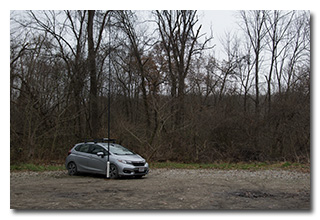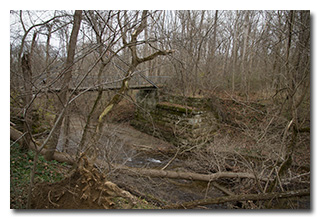
by William Eric McFadden
From the state nature preserve's website:
-
The prime feature of this preserve is a narrow, east-west gorge cut by the Licking River through the famous Black Hand sandstone formation. The name "Blackhand" originated from a dark, hand-shaped Indian petroglyph that was engraved on the face of a massive sandstone cliff along the north side of the river. The engraving was destroyed in 1828 during construction of the Ohio-Erie Canal, which went through the gorge. Sections of the canal towpath and canal locks may be seen from the trails along the river.
Pictures
Description
 On Saturday, November 27, 2021, one member of the Southeast Ohio Radio Adventure Team (SEORAT)
performed a successful activation of Black Hand Gorge State Nature Preserve in Ohio as part of the Parks on the
Air (POTA; link) program.
On Saturday, November 27, 2021, one member of the Southeast Ohio Radio Adventure Team (SEORAT)
performed a successful activation of Black Hand Gorge State Nature Preserve in Ohio as part of the Parks on the
Air (POTA; link) program.
Eric McFadden, WD8RIF, visited Black Hand Gorge State Nature Preserve at the Brownsville Road parking area on a very winter-like, gray, dreary, and cold late-Fall afternoon. This was the first CW POTA activation of Black Hand Gorge State Nature Preserve, the first-ever activation being a SSB activation performed by SEORAT-member Jeff Slattery, N8SUZ, on September 7, 2021. Eric was accompanied by his wife Vickie, KC8MAJ, and the two small dogs, Mindy and Theo.
Eric, Vickie, Mindy, and Theo arrived at the Brownsville Road parking area at 1925 UTC to find only one other vehicle in the parking area. While Vickie walked with Theo and Mindy dogs, Eric quickly deployed his 28½' wire antenna on the 31' Jackite telescoping fiberglass mast and drive-on base. Eric set up the KX3 inside the car and was on the air at 1936 UTC.
 Eric was pleased to find he had very good cell-signal at his location and was able to spot himself on POTA Spots (link)
and to use POTA Spots to look for park-to-park (P2P) opportunities.
Eric was pleased to find he had very good cell-signal at his location and was able to spot himself on POTA Spots (link)
and to use POTA Spots to look for park-to-park (P2P) opportunities.
Because this was the weekend of CQ Worldwide CW Contest, Eric had decided to concentrate his efforts on the contest-free WARC bands—in particular, on 60 and 30m.
Because it wasn't yet dark and contest activity wouldn't be strong on 80m, Eric began operations on 80m in order to give his friend K8RAT in central Ohio an opportunity but no QSOs were made on that band.
Switching to 60m at 1942 UTC, Eric's first QSO there came immediately with his friend K4SWL in western North Carolina. This was followed at 1943 UTC with a QSO with W2NR in New Hampshire and at 1944 UTC with a QSO with N2ESE in New Jersey.
Switching to 30m at 1947 UTC, Eric's first QSO there came at 1949 UTC and was a second QSO with W2NR in New Hampshire. This was followed at 1950 UTC with a QSO with KQ6UP who didn't send his QTH at 1951 UTC with a QSO with WD0ACB in Kansas.
When QSOs on 30m stopped coming, Eric used POTA Spots to identify P2P QSO opportunities and attempted to work KP4RK in Puerto Rico on 15m and AB9CA in Arizon on 20m but no QSOs were made.
Eric decided to give 40m a try despite the heavy CQWW contest activity on the band. Finding a frequency in the old Novice sub-band at 2002 UTC, Eric's first QSO on 40m came at 2004 UTC with WF4I in North Carolina. QSOs came quickly on 40m with Eric's fifth QSO on the band coming at 2009 UTC with KX4UI in Florida. This run included a third QSO with W2NR in New Hampshire.
In all, Eric made eleven QSOs in about thirty-three minutes. All of Eric's QSOs were CW and were made with five watts output.
(return)